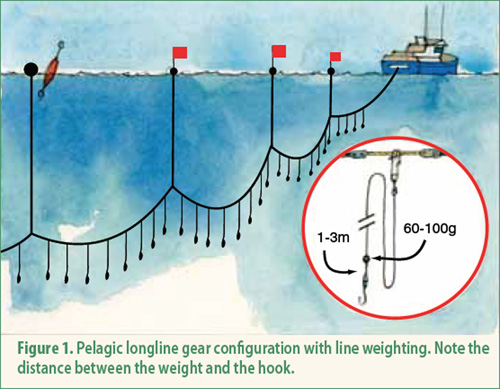The 6th Regular Session of the Scientific Committee of the Western and Central Pacific Fisheries Commission (WCPFC-SC6) was held over the period 10-19 August 2010 in Nukualofa, Tonga. A large number of documents relevant to the conservation of ACAP-listed albatrosses and petrels was tabled at the meeting (click here), including several presented by Warren Papworth, ACAP's Executive Secretary.
An update of the ecological risk assessment (ERA) presented to last year's meeting indicates that the area in the South Pacific where the most vulnerable seabirds are likely to be caught is likely to extend north to 25°S. It was noted that the Indian Ocean Tuna Commission (IOTC) has recently passed a resolution extending the region where its seabird management measures are applied to 25°S, and it was suggested that the WCPFC extend its own Conservation and Management Measure (CMM 2007-04 "Conservation and Management Measure to Mitigate the Impact of Fishing for Highly Migratory Fish Stocks on Seabirds), currently set only to operate south of 30°C, to be in line with IOTC current practice.
The meeting recommended that The Secretariat of the Pacific Community - Oceanic Fisheries Programme (SPC-OFP) and ACAP provide advice on observer data and information on seabird distribution to the WCPFC Secretariat after which a decision could be made on whether to proceed with a formal new analysis of risk levels of longline fishing to seabirds in this area.
The Scientific Committee (SC) noted that extensive research is currently underway aimed at providing a scientific basis for additional changes to CMM 2007-04 and that recent research undertaken by Edward Melvin (Washington Sea Grant, University of Washington, USA) and colleagues in the South African tuna fishery with the support of the Japan Tuna Fisheries Cooperative Association had highlighted the importance of line weighting of pelagic longlines. This is likely to be one of the most effective mitigation measures in reducing or eliminating seabird interactions with baited hooks, and the SC recommended further research be undertaken to enable refinement of the ‘weighted branch lines' specifications contained in CMM 2007-04.
The SC decided that amendments to CMM 2007-04 should not be made until such time as there are sufficient changes to warrant revision. It is expected that substantial findings will come out of research being undertaken over the next year and that these may provide the substantive changes required by the WCPFC's Scientific Committee.

Reference:
Edward F. Melvin, E.F., Guy, T.J. & Read, L.B. 2010. Shrink and defend: a comparison of two streamer line designs in the 2009 South Africa tuna fishery. WCPFC-SC6-2010/EB-IP-09.
John Cooper, ACAP Information Officer & Warren Papworth, ACAP Executive Secretary, 31 August 2010

 Français
Français  English
English  Español
Español